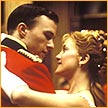
|
Desert drama
Arthur J Pais on the making of The Four Feathers
|
Shekhar Kapur and his team picked out several desert villages in Morocco as backdrop for the shooting of The Four Feathers. But the inhabitants of these little hamlets refused to allow Kapur's team to shoot without reason.
The filmmaker was puzzled. Nor could his team understand why the cameras were not being allowed to roll. But soon he knew.
The villagers were worried the young girls of their villages would get enamoured with the film's cast and crew. Where then would the village men find their brides?
It took quite a bit of persuasion to change their minds.
Kapur's The Four Feathers, an epic story of honour, betrayal, atonement and self-awareness, set against the background of British colonial world, takes place some three decades before the events in Lawrence Of Arabia unfolded.
Given the new movie's stunningly filmed scenes in the desert and its Muslim characters, Kapur is not surprised people have started comparing it to David Lean's Lawrence.
"But there is an important difference," Kapur says. "Lean and his team had about two years to shoot their film. We had just about three months." Though it took about two-and-half years for the casting, shooting and editing of the movie, the actual shooting took about 100 days. Most of the shoot was in Morocco where the desert, mountains and dunes represent Sudan.
Though much of the shooting took place in winter, the heat often was unbearable. "There are many ravishing sites in Morocco, but making the sites film-friendly was not at all easy," says production designer Marco Giacalone.
Kapur says he has endured extreme heat while shooting the Phoolan Devi saga Bandit Queen, but the Moroccan climate was quite something else, and that Bandit Queen was a far smaller project. The battle scenes in this movie involved over 1,300 extras and 200 animals and a principal cast of over a dozen men and women.
Kapur says cinematographer Robert Richardson, who won an Oscar for JFK, came out with a brilliant strategy to create the stark desert atmosphere. He shot into the sun. "By backlighting the shot, I was able to produce a sharp contrast between the characters and the landscape," explains Richardson, who was working for the first time with Kapur. The director says Richardson's technique was not a new one but what was new was that he used it for most of the film.
"It gave the film an edgy feeling," Kapur continues. "And a sense of total reality." Though Kapur handled a cast of half a dozen actors and about hundred extras for Bandit Queen, he says at every step, the challenge of making The Four Feathers was far bigger. Kapur says he has invested two-and-half years of his life to the project, but feels as if he has worked on it for a decade.
"I had to be very careful of the budget," he says, adding he is always conscious of budgetary constraints. "There were no studios involved with this film," he says referring to Paramount and Miramax. It is never easy to deal with one studio but here there were two, he adds with his trademark, disarming smile. The movie cost about $80 million.
Kapur says he wouldn't be surprised if people thought the film cost a huge fortune. "We worked under extraordinary circumstances," he says. "Extremely tough circumstances but everyone rose to the occasion. We shot fast, saving big money."